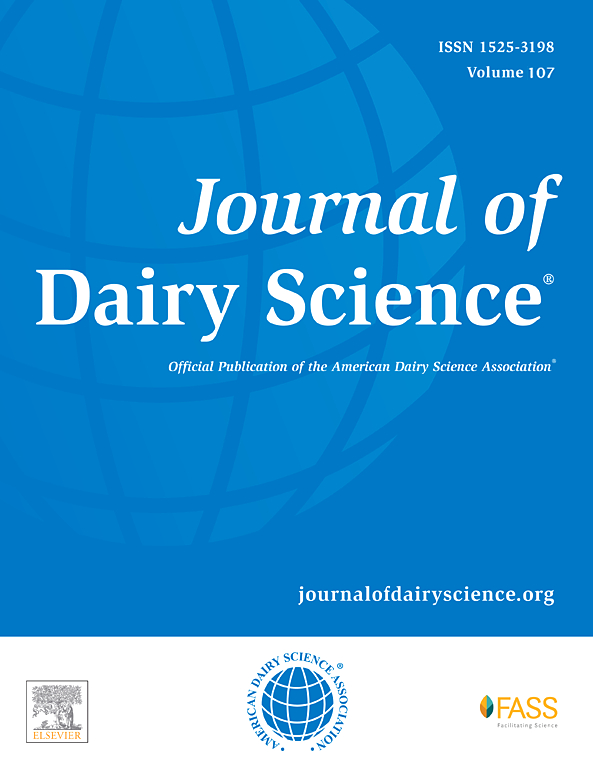综合多组学方法和病理分析为了解萨能山羊饮食暴露于黄曲霉毒素 B1 后的肝损伤和代谢改变提供了新的视角。
IF 3.7
1区 农林科学
Q1 AGRICULTURE, DAIRY & ANIMAL SCIENCE
引用次数: 0
摘要
探索黄曲霉毒素 B1(AFB1)在反刍动物体内的毒性和代谢机制有助于制定策略,防止或减少毒素及其代谢物向牛奶和肉类的转移。本研究旨在通过组织学检查、Western 印迹分析以及综合多组学技术,探讨三种浓度的日粮 AFB1(0、50 和 500 μg/kg)对萨能山羊肝损伤和代谢的影响。结果表明,随着 AFB1 水平的升高,肝脏组织增大,肝脏相对器官指数呈线性增加。Western 印迹结果显示,外部凋亡途径和线粒体介导的内在凋亡途径可能参与了 AFB1 诱导的肝细胞凋亡。对照组(C;0 μg/kg)和低剂量(L;50 μg/kg)、C 和高剂量(H;500 μg/kg)、L 和 H 比较,分别有 251、269、154 个显著差异表达基因(DEGs)和 340、596、127 个显著差异代谢物。注释的 DEGs 主要涉及细胞部分、细胞、单个机体过程、细胞过程、结合和其他功能类别。鉴定出的代谢物主要属于甘油磷脂、前烯醇脂、羧酸及其衍生物。转录组学和代谢组学的综合分析表明,甘油磷脂代谢和癌症中的胆碱代谢是受 AFB1 暴露影响最大的途径。所发现的差异代谢物、DEG 和通路可能在 AFB1 对山羊肝脏的损伤中发挥了关键作用。本文章由计算机程序翻译,如有差异,请以英文原文为准。
Integrated multiomics approach and pathological analyses provide new insights into hepatic injury and metabolic alterations in Saanen goats after dietary exposure to aflatoxin B1
Exploring the toxicity and metabolic mechanisms of aflatoxin B1 (AFB1) in ruminants can help to develop strategies to prevent or reduce the transfer of the toxin and its metabolites to milk and meat. This study aimed to explore the effects of 3 concentrations of dietary AFB1 (0, 50, and 500 μg/kg) on hepatic injury and metabolism in Saanen goats via histological examination, western blot analysis, as well as integrated multiomics techniques. Eighteen Saanen goats were assigned to 1 of 3 treatments and the AFB1 challenge lasted for 14 d. Results showed that the liver tissue was enlarged and the relative organ index of the liver was linearly increased with elevated AFB1 levels. The hepatocyte apoptosis rate was significantly increased after AFB1 exposure, and the western blotting results revealed that both the external apoptotic pathway and mitochondrial-mediated intrinsic apoptotic pathway might be involved in AFB1-induced hepatocyte apoptosis. We identified 251, 269, and 154 significant differentially expressed genes (DEG) and 340, 596, and 127 significant differential metabolites in comparisons between the control (CON; 0 μg/kg) and low-dose (LO; 50 μg/kg) groups, the CON and high-dose (HI; 500 μg/kg) groups, and the LO and HI groups, respectively. The DEG annotated were mainly involved in the cell part, cell, single-organism process, cellular process, binding, and other functional categories. The identified metabolites primarily belonged to glycerophospholipids, prenol lipids, carboxylic acids, and derivatives. Integrative analysis of transcriptomics and metabolomics revealed that glycerophospholipids metabolism and choline metabolism in cancer were the most affected pathways related to AFB1 exposure. The identified differential metabolites, DEG, and pathways might have played a crucial role in the hepatic injury induced by AFB1 in goats.
求助全文
通过发布文献求助,成功后即可免费获取论文全文。
去求助
来源期刊

Journal of Dairy Science
农林科学-奶制品与动物科学
CiteScore
7.90
自引率
17.10%
发文量
784
审稿时长
4.2 months
期刊介绍:
The official journal of the American Dairy Science Association®, Journal of Dairy Science® (JDS) is the leading peer-reviewed general dairy research journal in the world. JDS readers represent education, industry, and government agencies in more than 70 countries with interests in biochemistry, breeding, economics, engineering, environment, food science, genetics, microbiology, nutrition, pathology, physiology, processing, public health, quality assurance, and sanitation.
 求助内容:
求助内容: 应助结果提醒方式:
应助结果提醒方式:


